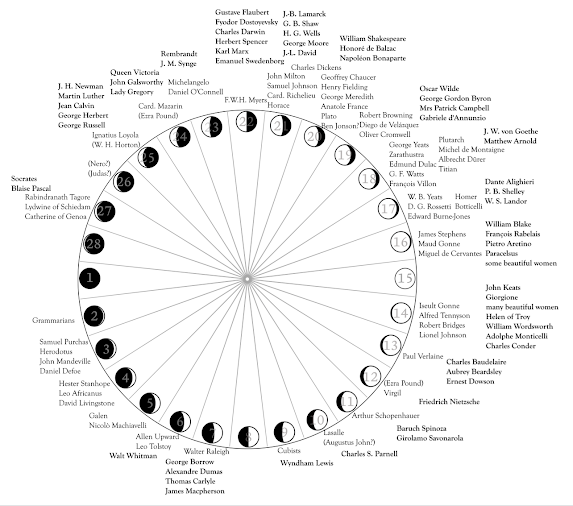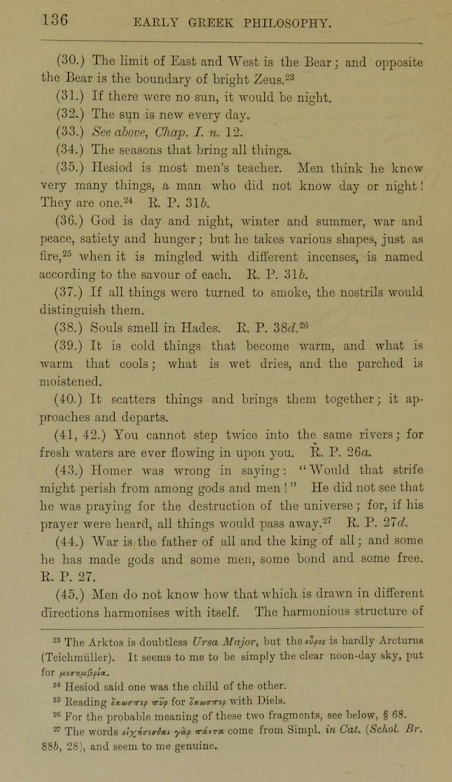[This is the first of a series of posts about the phases assigned to people in A Vision and the automatic script, some of them drawing on a presentation I gave to the International Yeats Society at the York conference in December 2021.]
What's Your Moon Phase?
Even those with only a cursory knowledge of A Vision, or perhaps even only the poem “The Phases of the Moon”, know that Yeats proposes a Great Wheel patterned on the phases of the moon, and that he assigns all human beings to one of the phases.
Though there are 28 phases, only 26 types of humanity are possible, as "there's no human life at the full or the dark" ("The Phases of the Moon"). It looks a little like astrology or any form of typing, with a spectrum of temperaments where the ends join, like in a colour wheel. It is recognizable as analogous to 12 Zodiac signs or maybe 16 Myers-Briggs combinations, and it is certainly one of the parts of A Vision that most people remember
The labelling, however, doesn't use memorable symbols. Each phase is assigned not an archetypal emblem but a vaguely suggestive title—such as “Assertion of Individuality,” “The Emotional Man,” or “The Saint”—and, in most cases, Yeats includes an irregular assortment of the people who fall under this phase.
In the Dedication to the 1925 edition of A Vision, Yeats claims that his predecessors like
Swedenborg and Blake and many before them knew that all things had their gyres; but Swedenborg and Blake preferred to explain them figuratively, and so I am the first to substitute for Biblical or mythological figures, historical movements and actual men and women.
It is not immediately clear what the names given share. Most would be hard-pressed to see the similarities between Napoleon and Shakespeare at Phase 20, though Balzac’s kinship to either might be a little easier to discern. George Russell, Æ, asked himself whether it was
insight or impishness which made [Yeats] link Bernard Shaw, H. G. Wells and George Moore as typical men of the twenty-first phase, or what old lady did he discover in Mr. Galsworthy to make him unite that novelist with Queen Victoria?
Russell was also
a little uncomfortable with some of [his] fellow-prisoners in phase twenty-five. I welcome George Herbert, but am startled to find myself along with Calvin, Luther and Cardinal Newman, as no doubt the last three would be incredulous of their own affinities to associate pilgrim souls.
Like Chaucer’s Canterbury pilgrims, the procession of souls embraces a gamut of types, but unlike Chaucer’s riders the range of professions and walks of life is considerably less varied. There is a heavy preponderance of literary figures in the pageant that Yeats unfolds, and the poets dominate.
 |
| The people assigned to the phases in A Vision (fictional characters excluded) |
Patterns of phases
Arranged on the Wheel, the names are a little crowded and not easily readable, but doing so clearly conveys the imbalances in the examples. The primary half of the Wheel (on the left-hand side here, centred on the New Moon at Phase 1) has some very empty spaces, particularly in Phases 2 to 5, while the antithetical half (on the right-hand side here, centred on the Full Moon at Phase 15) is far fuller. Even the antithetical half is more thinly populated in its early phases (9, 10, 11, 12), while the "early" phases of the primary (23, 24, 25) contain more names. Thus, the phases from 13 to 25 effectively account for the majority of the examples.
Some broad patterns emerge fairly quickly. The antithetical half is home to most of the creative artists: only two poets are placed outside the antithetical half, Walt Whitman and George Herbert, though James Macpherson, the "translator" of the Ossian poems, should probably also be added.
Of the poets, the Romantics are distributed through the more antithetical phases, with Keats and Wordsworth at Phase 14, Blake at Phase 16, Shelley at Phase 17, and Byron at Phase 19. (Strangely Coleridge is not included, though it is likely he would take Phase 18 along with the more philosophically minded Goethe.)
Political scientists such as Marx and Spencer are both placed at Phase 22, while evolutionary theorists Lamarck and Darwin are placed at 21 and 22, with Darwin in the more objective of the two.
Church reformers of various stripes are found at 25, with the iconoclast Savonarola directly opposite at 11, along with Spinoza whose philosophy seemed atheist to his contemporaries, while Nietzsche who proclaimed the death of god follows at Phase 12.
Interestingly three of Yeats's closest collaborators are placed in three consecutive primary phases: John Millington Synge at Phase 23, Lady Gregory at Phase 24, and George Russell (AE) at Phase 25.
I'll look at aspects of these groups in a little more detail in following posts, including some of the names that appear in the drafts but not in published version.







